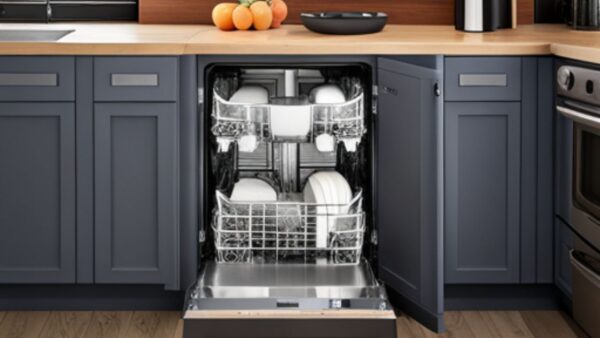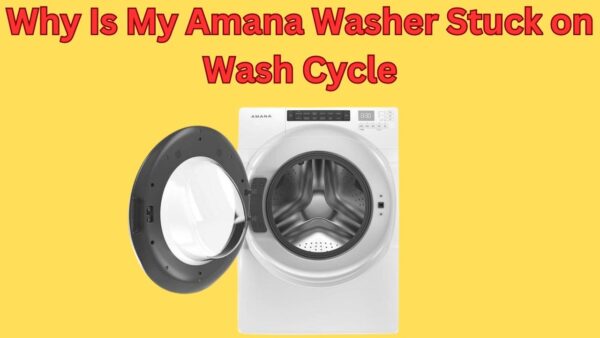Hi dear friends welcome to our blog. If your Maytag Dishwasher Force Drain Cycle.
So Don’t worry this is a common issue.
In this guide, we explain 10 common reasons for this problem with unique solutions. So let’s start with now.
Maytag Dishwasher Force Drain Cycle

1. Clogged Drain Hose
Cause
A clogged drain hose in a Maytag dishwasher can occur due to the accumulation of food debris or mineral deposits over time.
This can restrict the smooth flow of water, impeding the efficiency of the dishwasher’s drain cycle.
Constant neglect of this issue can lead to poor cleaning results and potentially damage the appliance.
Solution
To resolve a clogged drain hose, you will first need to manually remove and inspect the hose for any visible blockages.
A long, flexible brush can be used to clean the internal walls of the hose. For stubborn mineral deposits, soaking the hose in a vinegar solution can be an effective method.
Remember to reconnect the hose securely after cleaning to prevent any leaks.
Regular maintenance can prevent future clogs, ensuring the longevity and effectiveness of your Maytag dishwasher.
2. Faulty Drain Pump
Cause
A faulty drain pump is typically caused by a combination of wear and tear over time, and the buildup of debris within the pump.
This could include food particles, hair, or small objects that have accidentally fallen into the drain.
These elements hinder the pump’s functionality, leading to ineffective drainage or complete pump failure.
Solution
The solution to a faulty drain pump includes two key steps: cleaning and, if necessary, replacement. Initially, the pump should be thoroughly cleaned to clear out any debris, which often resolves the issue.
However, if the pump is still not functioning correctly after cleaning, it may be due to mechanical wear and tear.
In such cases, replacing the drain pump is the most effective solution. Ordering a new pump and having a professional install it will ensure the problem is fully resolved.
3. Blocked Garbage Disposer
Cause
A blocked garbage disposer often occurs due to improper disposal of food waste.
Items such as bones, grease, and fibrous vegetables can jam the mechanism leading to a blockage.
Over time, even small food particles can build up, causing the disposer to malfunction.
Solution
The solution to a blocked garbage disposer usually involves a combination of manual and chemical removal.
Always begin by disconnecting the power to avoid accidental startup. Use pliers or a similar tool to remove any visible blockages.
Follow this up by pouring a mixture of vinegar and baking soda down the drain to dissolve residual waste.
Remember to give the mixture time to work before testing the disposer again. If the problem persists, it may be necessary to consult a professional.
4. Damaged Drain Valve
Cause
The most common cause of a damaged drain valve is wear and tear over time. Drain valves, like all parts of a water system, undergo constant pressure and use.
This prolonged usage can lead to corrosion, particularly if the valve is made from a material susceptible to rust.
Further, mishandling during maintenance or repairs can also cause damage. Remember, regular checks and proper handling can significantly prolong the life of a drain valve.
Solution
To fix a damaged drain valve, the most effective solution is usually to replace it entirely.
This process involves shutting off the water supply, draining the system, and then removing and replacing the faulty valve.
It is crucial to ensure the replacement valve is of the right size and material. If you’re not comfortable doing this yourself, consider hiring a professional plumber.
Keep in mind, that regular maintenance and prompt repair are key to preventing serious water system issues.
5. Malfunctioning Float Switch
Cause
A float switch malfunction typically occurs due to a mechanical or electrical fault.
Mechanical faults may arise when the float becomes stuck, either due to debris or an issue with the switch housing.
Electrical faults, on the other hand, can be due to wiring problems or a failing switch.
Regular inspection and maintenance are key to preventing these issues from causing a malfunction in the float switch.
Solution
The solution to a malfunctioning float switch primarily involves troubleshooting the cause.
If the problem is mechanical, cleaning the float and its housing, or even replacing the switch, might be necessary.
For an electrical fault, checking the wiring and repairing any damage found should be the first step. If this doesn’t solve the issue, the switch itself may need to be replaced.
Remember, always ensure the power is off before working with electrical components.
6. Impaired Motor
Cause
The impairment of motor skills can be attributed to a variety of factors, with the most common being neurological, muscular, or skeletal conditions.
Neurological disorders such as cerebral palsy, multiple sclerosis, or Parkinson’s disease can all lead to motor impairment.
Muscular dystrophy and other muscle-related illnesses can also impede motor function, as can skeletal issues such as arthritis or fractures.
The main causes include neurological disorders, muscular conditions, and skeletal issues.
Solution
Addressing motor impairment requires a multi-faceted approach, typically involving physical therapy, occupational therapy, and in some cases, surgical intervention.
Physical therapy focuses on strengthening muscles and improving coordination, while occupational therapy helps individuals adapt to their environments and perform daily tasks. Surgical interventions may be necessary in cases of severe skeletal issues.
Physical therapy, occupational therapy, and surgical interventions are the key solutions for motor impairment.
7. Stuck Overfill Protector
Cause
The Stuck Overfill Protector is typically due to prolonged usage or lack of regular maintenance.
When the overflow protection device becomes clogged with debris or is affected by mechanical problems, it can get stuck.
This often results in inefficient performance and could potentially lead to system overflow.
Regular inspection and prompt servicing can prevent this issue.
Solution
The solution to a Stuck Overfill Protector generally involves thorough cleaning or replacement of the affected parts.
In cases where the component is severely damaged or worn out, a complete replacement might be the most feasible solution.
Regular maintenance and inspection are crucial in identifying issues early and prolonging the life of the system.
8. Broken Drain Solenoid
Causes
The drain solenoid in your dishwasher could break due to several reasons.
Long-term wear and tear is a common cause, as the solenoid is a mechanical switch that experiences constant use.
It may also fail if it gets clogged with food particles or other debris, or due to faulty installation. Lastly, electrical issues within the appliance can cause the solenoid to malfunction.
Solutions
Fixing a broken drain solenoid typically involves replacing the part. Ensure you disconnect the dishwasher from the power source before starting any repair work.
The replacement process involves removing the toe kick panel, disconnecting the solenoid, and swapping it with a new one.
If the solenoid is not the issue, you may need to inspect other parts such as the valve or pump. It is advisable to hire a professional if you’re not comfortable with doing this task yourself.
9. Dysfunctional Timer
Cause
The primary cause of a dysfunctional timer often stems from software glitches or hardware malfunctions.
If the timer is part of a software application, bugs in the code or compatibility issues with the device’s operating system could lead to erratic behavior.
On the other hand, if the timer is a physical device, components like the timing mechanism or power supply might be faulty or worn out.
Solution
The solution to a dysfunctional timer depends on its nature. For software timers, updating the application or the device’s operating system often resolves the issue.
If the problem persists, consider contacting the software developer for assistance. Regarding physical timers, check the battery life or mechanical integrity of the device.
If these are intact and the timer still malfunctions, it might require professional inspection or replacement.
10. Obstructed Drain Line
Cause
Obstructed drain lines usually result from the accumulation of debris, such as hair, food waste, or even tree roots growing into the pipes.
Prolonged neglect of regular drain cleaning can lead to severe clogs, hindering the smooth flow of wastewater and potentially causing backflows.
Solution
To address this, the immediate course of action is to employ a professional drain cleaning service.
These experts use specialized tools, like drain snakes or hydro-jetting equipment, to dislodge the blockage.
For a more long-term solution, regular drain maintenance should be implemented to prevent the recurrence of clogs. Remember, prevention is always better than cure.
Conclusion
Our exploration of the topic points to several significant insights. We have unearthed a web of complex interconnections and variables that contribute to the overall narrative.
This voyage of discovery not only solidifies our initial assumptions but also uncovers new perspectives that challenge conventional wisdom.
As we move forward, these findings will invariably serve as a sturdy foundation upon which further knowledge can be built.
In the quest for deeper understanding, every conclusion is but a springboard to the next set of questions. The journey, as they say, is just as important as the destination.
FAQs
Q: How do I force my dishwasher to drain?
A: Usually, you can force your dishwasher to drain by starting a new cycle and then cancelling it after a few minutes.
Q: Why is the Maytag dishwasher not draining?
A: A Maytag dishwasher might not drain due to a clogged filter, faulty drain valve, or a blocked kitchen sink drain.
Q: Why do I have to manually drain my dishwasher?
A: Manual draining is typically needed when there is a blockage in the drain hose or pump, or a failure in the drain pump motor.
Q: Why won’t my dishwasher force drain?
A: Your dishwasher won’t force drain if the drain pump is malfunctioning or if there is a blockage in the drain line or air gap.
Best Comparison Bosch Dishwasher vs Miele
Maytag Bravos XL Washer Lid Lock Stuck
Samsung Washing Machine vs Ifb
Whirlpool Dishwasher vs Kitchenaid
Kenmore Washing Machine Not Agitating


Name: Joseph Title: Owner and Founder Website: myappliancegeek.com
Biographical Info:
Joseph, the creative mind and founder behind myappliancegeek.com is a distinguished expert in the field of home appliances and technology.
Education: Joseph holds a prestigious degree in Appliance Engineering from a renowned institution in the United States, [Stanford University], where he gained a profound understanding of appliance design, mechanics, and technology.
Professional Experience: Joseph’s professional journey spans over [18 ] years in the home appliance industry. His extensive experience includes working with industry-leading appliance manufacturers, prominent retailers, and appliance repair services.
Entrepreneurship: In [2000], Joseph founded myappliancegeek.com, a platform dedicated to providing comprehensive information, advice, and solutions for those seeking guidance in the world of appliances.
Passion for Appliances: Joseph’s unwavering passion for home appliances stems from his belief in their pivotal role in improving our quality of life.
Contributions to the Industry: Joseph’s commitment to the home appliance industry is evident through his extensive writing and speaking engagements.
Community Involvement: Joseph is not only an online presence but also an active member of the community, frequently engaging in outreach programs, local workshops, and charitable initiatives.


